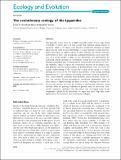Files in this item
The evolutionary ecology of the Lygaeidae
Item metadata
| dc.contributor.author | Burdfield-Steel, Emily R. | |
| dc.contributor.author | Shuker, David M. | |
| dc.date.accessioned | 2014-08-12T10:01:02Z | |
| dc.date.available | 2014-08-12T10:01:02Z | |
| dc.date.issued | 2014-06 | |
| dc.identifier | 139787879 | |
| dc.identifier | 2b128c7f-f979-4410-807d-0bd0feafe8d4 | |
| dc.identifier | 000337522200022 | |
| dc.identifier | 84901779876 | |
| dc.identifier | 000337522200022 | |
| dc.identifier.citation | Burdfield-Steel , E R & Shuker , D M 2014 , ' The evolutionary ecology of the Lygaeidae ' , Ecology and Evolution , vol. 4 , no. 11 , pp. 2278-2301 . https://doi.org/10.1002/ece3.1093 | en |
| dc.identifier.issn | 2045-7758 | |
| dc.identifier.uri | https://hdl.handle.net/10023/5115 | |
| dc.description | ERB-S was supported by a Natural Environmental Research Council PhD studentship. | en |
| dc.description.abstract | The Lygaeidae (sensu lato) are a highly successful family of true bugs found worldwide, yet many aspects of their ecology and evolution remain obscure or unknown. While a few species have attracted considerable attention as model species for the study of insect physiology, it is only relatively recently that biologists have begun to explore aspects of their behavior, life history evolution, and patterns of intra- and interspecific ecological interactions across more species. As a result though, a range of new phenotypes and opportunities for addressing current questions in evolutionary ecology has been uncovered. For example, researchers have revealed hitherto unexpectedly rich patterns of bacterial symbiosis, begun to explore the evolutionary function of the family's complex genitalia, and also found evidence of parthenogenesis. Here we review our current understanding of the biology and ecology of the group as a whole, focusing on several of the best-studied characteristics of the group, including aposematism (i.e., the evolution of warning coloration), chemical communication, sexual selection (especially, postcopulatory sexual selection), sexual conflict, and patterns of host-endosymbiont coevolution. Importantly, many of these aspects of lygaeid biology are likely to interact, offering new avenues for research, for instance into how the evolution of aposematism influences sexual selection. With the growing availability of genomic tools for previously non-model organisms, combined with the relative ease of keeping many of the polyphagous species in the laboratory, we argue that these bugs offer many opportunities for behavioral and evolutionary ecologists. | |
| dc.format.extent | 24 | |
| dc.format.extent | 2203062 | |
| dc.language.iso | eng | |
| dc.relation.ispartof | Ecology and Evolution | en |
| dc.subject | Ecology | en |
| dc.subject | Entomology | en |
| dc.subject | Evolution | en |
| dc.subject | Life history | en |
| dc.subject | Lygaeidae | en |
| dc.subject | Sexual selection | en |
| dc.subject | Milkweed bugs oncopeltus | en |
| dc.subject | Lygaeus-equestris heteroptera | en |
| dc.subject | Metathoric scent gland | en |
| dc.subject | Life-history traits | en |
| dc.subject | Hinipennis costa heteroptera | en |
| dc.subject | Huttoni white heteroptera | en |
| dc.subject | Bicrucis say heteroptera | en |
| dc.subject | Aposematic seed bugs | en |
| dc.subject | Hemiptera-lygaeidae | en |
| dc.subject | QH301 Biology | en |
| dc.subject.lcc | QH301 | en |
| dc.title | The evolutionary ecology of the Lygaeidae | en |
| dc.type | Journal item | en |
| dc.contributor.institution | University of St Andrews. School of Biology | en |
| dc.contributor.institution | University of St Andrews. Scottish Oceans Institute | en |
| dc.contributor.institution | University of St Andrews. Institute of Behavioural and Neural Sciences | en |
| dc.contributor.institution | University of St Andrews. Centre for Biological Diversity | en |
| dc.identifier.doi | 10.1002/ece3.1093 | |
| dc.description.status | Peer reviewed | en |
This item appears in the following Collection(s)
Items in the St Andrews Research Repository are protected by copyright, with all rights reserved, unless otherwise indicated.

